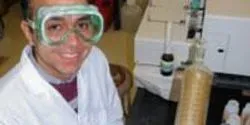Environmental Lab

A University of Washington (UW) survey of pollution and other impurities in North American snow required researchers to find sites with undisturbed snow far from any city or major road – in other words, a recipe for getting stranded by the side of a cold, lonely road.

The southeastern United States is a natural laboratory for scientists studying how chemicals emitted by human activities and trees interact with each other and affect air quality and climate. A new study has found that certain emissions from cars and coal-fired power plants promote processes that transform naturally occurring emissions from trees into organic aerosols. Organic aerosols make up a substantial fraction of ambient particulate matter (PM) that can affect climate, air quality and human health.

The Taj Mahal’s iconic marble dome and soaring minarets require regular cleaning to maintain their dazzling appearance, and scientists now know why. Researchers from the United States and India are pointing the finger at airborne carbon particles and dust for giving the gleaming white landmark a brownish cast.

Growing concerns about water scarcity and climate change have given rise to a new branch of research that has found its way to Clemson University and could help deal with some the globe’s biggest environmental challenges.

Using a new imaging technique, National Institutes of Health researchers have found that the biological machinery that builds DNA can insert molecules into the DNA strand that are damaged as a result of environmental exposures. These damaged molecules trigger cell death that produces some human diseases, according to the researchers. The work, appearing online Nov. 17 in the journal Nature, provides a possible explanation for how one type of DNA damage may lead to cancer, diabetes, hypertension, cardiovascular and lung disease, and Alzheimer’s disease.

Thermo Fisher Scientific has developed a simple, reliable and robust method for detecting dissolved gases in water using a gas chromatograph equipped with an autosampler and an electron flame ionization detector (FID).












